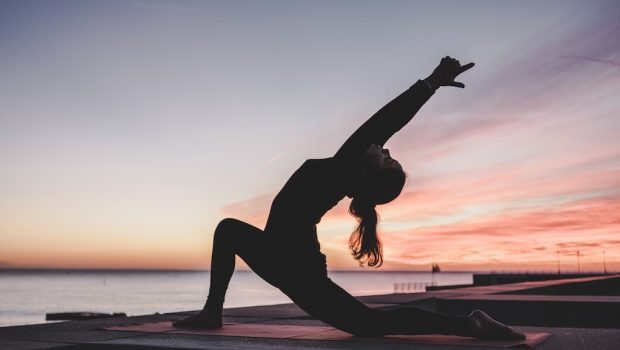How Can Yoga Help Boost Your SUP Performance?
When you love a sport with all your heart, it can drown out many other sporting interests, but as a study by Brown University scientists found, diversifying – and embracing holistic practices such as yoga – can actually help you prevent injury and perform at your best. The academics recommended that athletes who specialize in a sport such as SUP add other types of training to their routine, mentioning yoga and conditioning training, in particular. Yoga can actually be an ideal ‘second activity’ while you are training for your next SUP competition, since it comes with a range of physical and mental benefits that tie in perfectly with your needs as an athlete.

Strengthening Core Muscles
SUPers need significant strength in many major muscle groups – including those located in their core, lower back, shoulders and arms. Yoga has major benefits for all these muscle groups. A study by C Woodyard published in the International Journal of Yoga has shown, for instance, that yoga sessions “enhance muscular strength and body flexibility, promote and improve respiratory and cardiovascular function, promote recovery from and treatment of addiction, reduce stress, anxiety, depression, and chronic pain, improve sleep patterns, and enhance overall well-being and quality of life.” Of course, flexibility and range of motion are as necessary as muscular strength when it comes to reacting to changes imposed by the movement of water. During one day out on the water, an SUPer may need to stretch into a required position, quickly change their body positioning, and/or maintain a challenging position for a long period of time.
Yoga And Core Stability
Yoga asanas are particularly beneficial for core stability, which boosts sporting performance and injury prevention. These asanas (or postures) require the coordinated movement of many major and minor muscle groups. Many postures actually focus on muscular and skeletal alignment, differing from traditional sports that focus on one specific group of muscles. Even beginner asana such as the warrior, boat and tree poses improve balance and strength, and enhance whole-body movement.
Making Yoga Motivating
Scientists know why yoga makes athletes feel so good – a UCLA study showed, for instance, that just 12 minutes of yogic meditation, undertaken for eight weeks, causes a big decrease in the immune system’s inflammatory response (and it is well known that inflammation is linked to a host of chronic diseases). In addition to yoga’s health effects, this holistic practice can also be loads of fun if you find ways to motivate yourself. Try signing up for a group class, enjoy an online session, and of course, wear comfortable clothing. Simple leggings and a T-shirt will do. Since yoga is all about achieving a comfortable, tranquil state, opt for a soft material. Organic cotton T-shirts are soft and resistant, and are always a good option. For something really sturdy, try pima cotton, a fabric with extra long fibers that add an extra touch of softness to T-shirts. Ensure your shoes are up to scratch too. Top qualities to look out for in shoes include a light weight, flexibility, breathability, traction (if you will be practicing outdoor yoga), and of course, comfort

Yoga And Stress
Chronic stress puts the body into ‘fight or flight’ mode, thereby hampering human functioning in cognitive/academic ability as well as physical/sporting feats. As found by Jones and Hardy, high levels of stress can lead to anxiety and burnout, which are strongly linked to an inability to manage stress in sport. Study after study has shown that yoga has a powerful ability to lower levels of stress hormone, cortisol. As such, it is a practice that is commonly used among those battling conditions such as stress, anxiety, depression and PTSD. Yoga also has an important role to play in sport. In addition to helping SUPers focus and handle stress and anxiety, it can also enhance positive thinking and promote better self-care.
Easy Exercises for SUPers
If you’d like to start out with a few asanas/poses, why not do so on your board? Start out with the seating pose, crossing one leg over the other and sitting up straight while practising abdominal breathing exercises. You can proceed to stretch on your board, using the child’s pose – kneel down on your board with your toes together and your knees at hip-width. Rest your belly between you things and your forehead down on the paddle, with your arms stretched out at the sides of your head. Feel the delicious stretch for a few seconds before letting it go and repeating the exercise. A third exercise beginners can easily accomplish is the cobra. Lie down on the board on your belly, place your hands beneath your shoulders and straighten your arm out while you bend backwards in a graceful arch. Inhale as you lift your head and bend your neck backward. You can additionally perform lunges; maintain the lunge position for various seconds and lift your arms straight upwards to the sides of your head; you can also add a twist by placing one palm on the board and lifting the other towards the sky.
Yoga And Confidence
Energy is one thing you need a lot of to perform at your very best when out on the water, and yoga can help give you a boost in this department. As found in a study by A Golec de Zavala and colleagues, yoga poses can help boost subjective energy and self-esteem. The researchers reported that yoga enables people to view themselves more positively, most probably because of the effects that body alignment can have on the nervous system. As stated by the researchers, “Yoga poses emphasize opening and lifting of the chest and stimulate the vagal nerve. They are not associated with competition or dominance, but they are likely to increase physical energy and subjective sense of energy and empowerment.”
If you are looking to expand your workout to include non-SUP activities, yoga is a good way to start. This millenary practice has been found to boost strength and flexibility. It is also a powerful antidote to stress and anxiety, and a wonderful way to achieve a quality that can be so helpful when you are out on the water – mindfulness.
Words by Sara Zipf.








